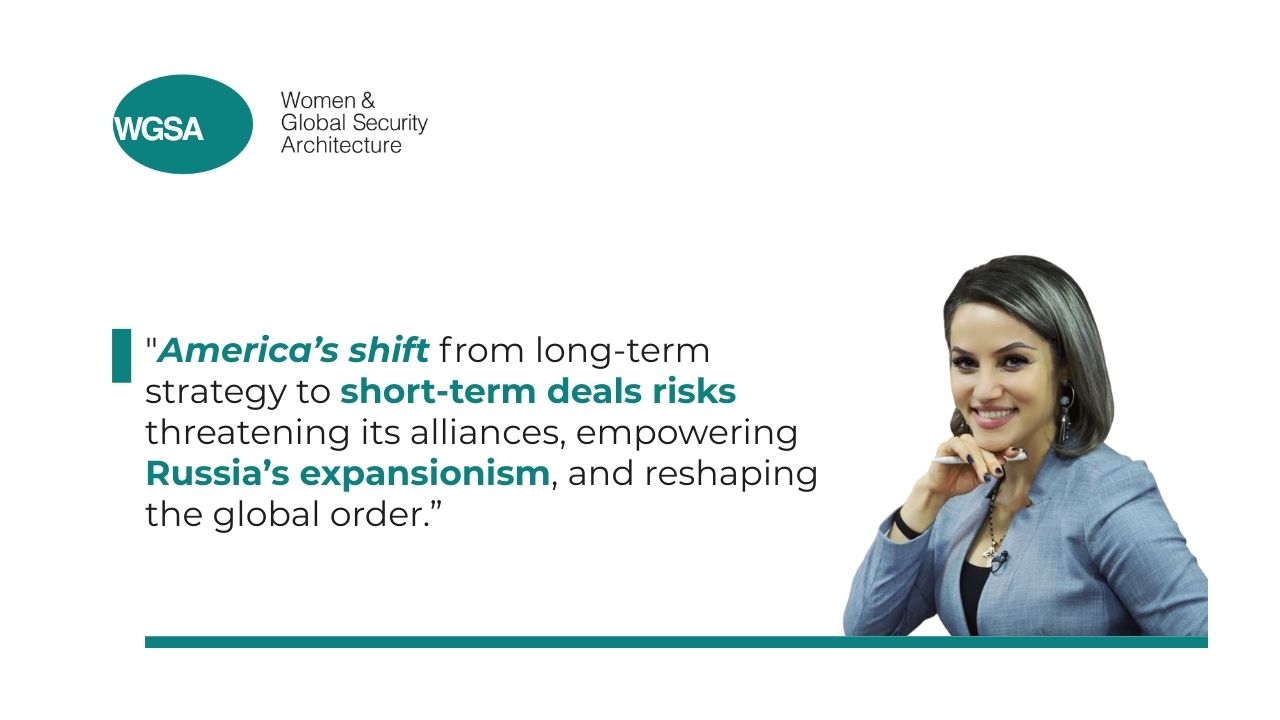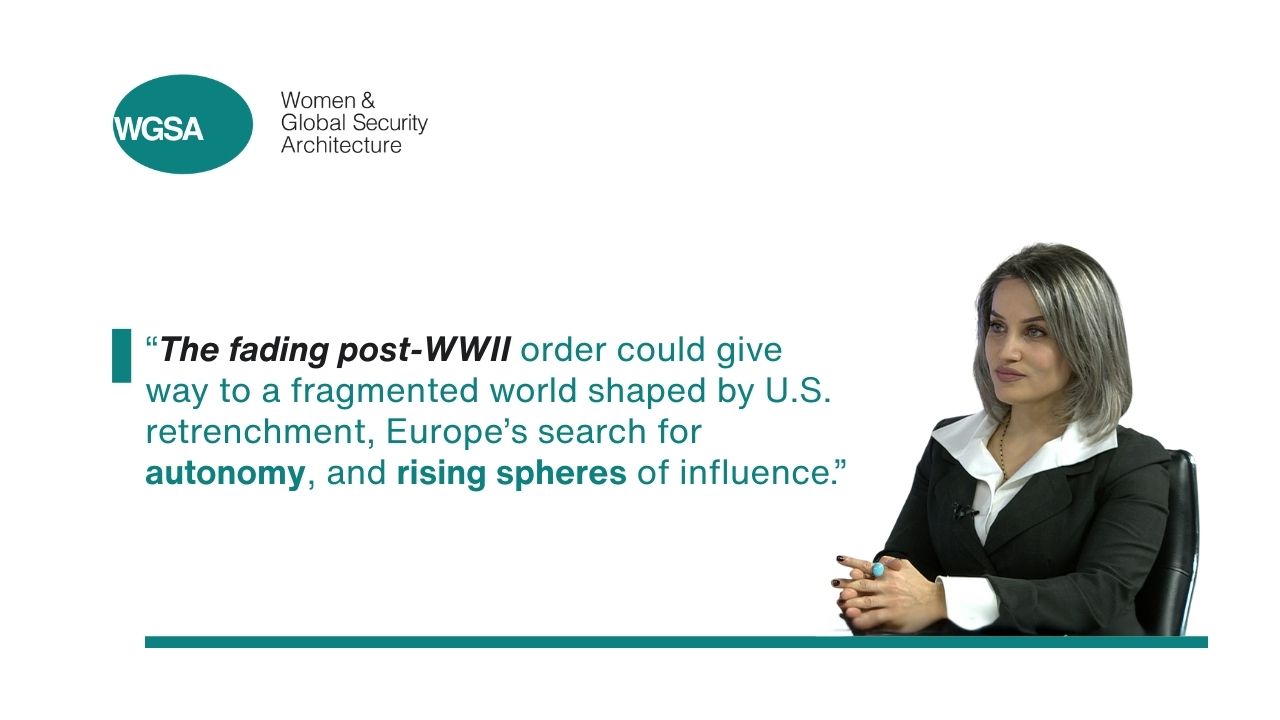Turning Geopolitics into Commerce: The Implications of U.S. Foreign Policy in a Changing Global Order

By Elen Hokhikyan, WGSA Associate Expert
The evolving dynamics of global politics have been significantly shaped by the actions of the United States, particularly under the leadership of the President Donald Trump. Many analysts have struggled to interpret his policies, often attempting to decipher deeper strategic motives behind his decisions. However, a more straightforward approach suggests that Trump operates in a transactional manner, treating international relations as business deals with immediate gains rather than as long-term strategic investments. His disruption of the existing international order has had profound implications, from trade wars with allies to the erosion of the U.S.’s global credibility.
The Transactional Approach and Its Costs
Trump’s foreign policy has been characterized by a series of abrupt shifts, including trade wars and ideological confrontations with traditional allies. These moves, rather than securing economic stability, will impose significant financial burdens on American consumers and businesses. Ironically, many of those who supported Trump did so based on promises of reduced costs and inflation control, yet his policies are set to achieve the opposite effect.
A particularly stark example of this disruption is his approach to Europe. By undermining traditional alliances and fostering uncertainty around commitments, Trump has weakened transatlantic cooperation. European nations, once firm partners of the U.S., are now reevaluating their security frameworks, realizing that the old World Order and longstanding agreements may no longer be reliable.
The Erosion of U.S. Global Standing
By shifting away from its European allies and aligning with regimes that challenge the post-WWII global order, the United States risks isolating itself. This trajectory became evident during recent United Nations votes, where the U.S. found itself aligned with authoritarian regimes like Russia, North Korea and Belarus. Such moves do little to advance the goal of “making America great again.” Instead, they diminish the country’s influence, leaving it detached from the collective strength of democratic alliances.
Furthermore, Trump’s stance on Ukraine raises significant concerns. His reluctance to support Ukraine against Russian aggression signals a departure from the principles of democratic sovereignty. Russia, despite its claims that NATO expansion was the catalyst for war, has long harbored ambitions of reclaiming former Soviet territories. By hesitating to back Ukraine fully, the U.S. risks emboldening Moscow’s imperialist aspirations, potentially triggering further instability in Europe.
Neo-Imperialism and the Russian Propaganda Machine
A growing faction within U.S. isolationist circles has adopted Russian narratives, claiming that NATO’s expansion provoked Russia’s invasion of Ukraine rather than Putin’s irredentist aspirations. This perspective, however, aligns more closely with Russian propaganda than with geopolitical realities.
For the last decade or so, Moscow has been actively cultivating the notion that Russia must return to its imperial roots. Following the annexation of Crimea in 2014, Russian state media increasingly propagated the belief that the dissolution of the Soviet Union was a historical mistake. Putin himself has repeatedly asserted that its collapse was the “greatest geopolitical catastrophe” of the 20th century and the demise of the “historical Russia”. His rhetoric and actions underscore a long-term strategy aimed at reassembling former Soviet territories under Moscow’s control.
The argument that NATO’s presence provoked Russia into invading Ukraine is flawed. NATO had maintained a presence in Eastern Europe for decades, yet it was Russia’s unprovoked aggression that prompted historically non-aligned nations like Finland and Sweden to seek NATO membership, bringing the alliance even closer to Russia’s borders—an expansion that, notably, did not provoke the same level of outrage from Moscow at that time.This alone debunks the claim, that NATO’s expansion was the primary catalyst for conflict.
Russian state-controlled media figures, such as Vladimir Solovyov, continue to advocate for imperial restoration, asserting that Russia’s survival depends on reclaiming lost territories. These ambitions have materialized in Ukraine, where the Kremlin labels its aggression as “liberation” and has unilaterally annexed 4 Ukrainian regions or about 15% of Ukraine’s territory (Donetsk, Kherson, Luhansk, Zaporizhzhia). Putin has openly denied Ukraine’s legitimacy as a sovereign state, arguing that Ukraine is merely an extension of historical Russian lands. In an article published on the Kremlin’s official website, he asserted that Ukrainians, Russians, and Belarusians “are all descendants of Ancient Rus,” reinforcing his justification for territorial expansion.
However, contrary to Russia’s expectations of a swift victory, Ukraine has mounted a formidable resistance, turning what was projected as a three-day operation into a grueling three-year conflict, highlighting the strategic miscalculations of Russia’s neo-imperial ambitions.
The Economic and Strategic Fallout
The prolonged war has devastated Ukraine and strained Russia’s own economy. Mounting casualties, economic sanctions, and the loss of critical trade partnerships have weakened Moscow’s position, forcing it into deeper reliance on authoritarian allies like China and North Korea. But the geopolitical stakes extend far beyond the conflict itself.
Regardless of how or when the war concludes, the United States must carefully consider its postwar stance toward Russia. Its approach will not only determine the security and stability of Europe but also shape the broader global order. As the world braces for the aftermath of the Ukraine conflict, Washington must proactively define the role it envisions for itself—one that ensures its alliances remain intact and its influence endures in a rapidly transforming geopolitical landscape.
